Hermanos Solesio
“Money Bag” pattern by Hermanos Solesi, late 18th c.
Spanish National Pattern / “Money Bag” Type
Money Bag pattern by Hermanos Solesio (Caietano and Pedro Maria Solesio), Genoa, late 18th c. The Fratelli Solesio factory in Genoa supplied regional patterns to many overseas markets. Once their reputation had been established, the name Hermanos Solesi (or Solesio) was used in the Spanish speaking markets. In this example, the ace of coins has the arms of Spain with two scrolls reading “Hermanos Solesi”. However, the sota (or Jack) of coins holds a bag full of money in his right hand, which, along with other features, is a distinctive variation of the Spanish National pattern, associated primarily with Italian card makers from the Finale Ligure region.


Above: “Money Bag” pattern by Hermanos Solesi, woodcut and stencils, late 18th century. The four of coins has the initials F.S. [Fratelli Solesi] and a rising sun motif. Note also the trefoil device on the four of cups.
The Fratelli Solesi playing card factories in Genoa exported their wares far and wide. In this way, examples of this pattern reached Spanish dependencies in Manila (Philippines), Peru and Mexico, where, due to its popularity, were sought after and imitated by local manufacturers. This became a challenge for the Official Spanish monopoly in those territories to cards produced in the Royal factory at Macharaviaya (Malaga). The Money Bag pattern also appeared at the Impressão Régia (Lisbon) via Lorenzo María Solesio, Félix Solesio’s older brother, who worked there. Examples are also known produced by Félix Solesio himself. Surprisingly, in spite of its popularity, this pattern was not produced at the Royal factory at Macharaviaya.
Another Example
“Baraja que viene de Europa y cuesta dos reales”.

Above “Money Bag” pattern by Fratelli Solesi, mid-late 18th century. 48 cards. The two of cups has the inscription “En Final”. © Ministerio de Educación, Cultura y Deporte. Archivo General de Indias MP Ingenios y Muestras 246.
CREDITS & REFERENCES
Additional research by Alberto Pérez González.
Denning, Trevor: The Playing-Cards of Spain, Cygnus Arts, London, 1996
Pérez González, Alberto: Una introducción y dos precisiones, in “La Sota” Nº19, Asescoin, Madrid, 1998.
Pérez González, Alberto: Anexo: La Baraja Perdida de Félix Solesio, in “La Sota” Nº38, pp.76-77, Asescoin, Madrid.
A further example of this pattern by Hermanos Solesio can be viewed on the British Museum website►

By Simon Wintle
Member since February 01, 1996
Founder and editor of the World of Playing Cards since 1996. He is a former committee member of the IPCS and was graphics editor of The Playing-Card journal for many years. He has lived at various times in Chile, England and Wales and is currently living in Extremadura, Spain. Simon's first limited edition pack of playing cards was a replica of a seventeenth century traditional English pack, which he produced from woodblocks and stencils.
Trending Articles
Popular articles from the past 28 days
Related Articles

Woodblock and Stencil Joker
A limited edition art print of the 1984 woodblock joker.
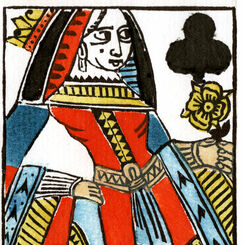
Woodblock and Stencil Queen of Clubs
A limited edition art print of the Queen of Clubs 1984 woodblock joker.
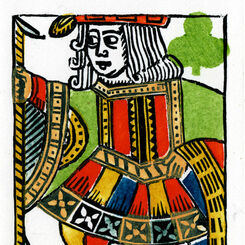
Woodblock and Stencil Jack of Clubs
A limited edition art print of the Jack of Clubs 1984 woodblock joker.

Woodblock and Stencil Jack of Hearts
A limited edition art print of the Jack of Hearts 1984 woodblock joker.

Poker Lusso
Richly costumed courts on a luxury poker pack from Masenghini.
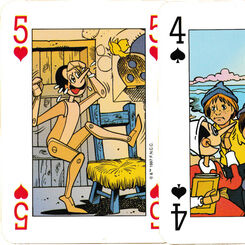
Pinocchio playing cards
Comic book drawings inspired by Carlo Collodi’s children’s classic, Pinocchio.
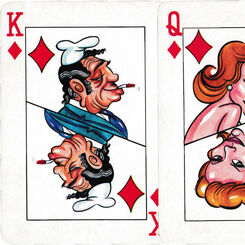
Le Ore playing cards
Caricatures of famous personalities from the late 1970s for the Italian magazine Le Ore.
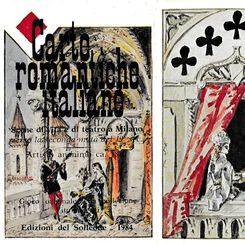
Carte Romantiche Italiane
Scenes of life and the theatre in Milan towards the second half of the 19th century.
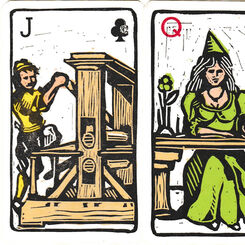
Lo Stampatore
‘Lo Stampatore’ linocut images created by Sergio Favret, published as a deck of cards by Editions So...

Leonardo collection
Leonardo collection playing cards with drawings from his notebooks.
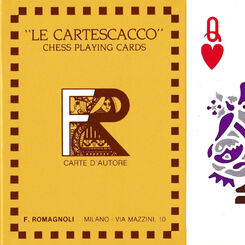
Lo Cartescacco / Chess playing cards
Playing cards designed by F. Romagnoli bringing together Chess and Bridge, Italy, c. 1981.
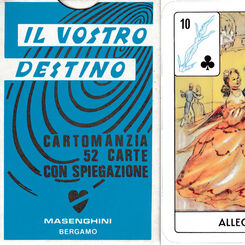
Il Vostro Destino
Italian fortune-telling pack produced by Viassone and later by Masenghini.
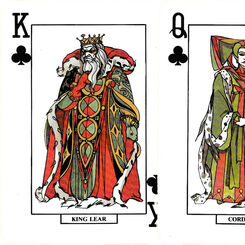
San Paolo Shakespeare
San Paolo Shakespeare, Italy, 1978

Le Carte di Forattini
Political caricatures by Giorgio Forattini published by Arnoldo Mondadori Editore, Italy, 1993.

San Paolo Chekhov
Characters from Chekhov’s plays designed by Paolo Fresu for San Paolo Istituto Bancario, Italy, c.19...

Storia del Fascismo - gioco di carte
‘Storia del Fascismo’ playing cards depicting persons, symbols and artifacts associated with Italian...

The Lovers playing cards
Reproductions of old postcards with romantic messages for Valentine’s Day.

I Gatti Originali di Evelyne Nicod
Etchings of cats on a set of major arcana created by Evelyne Nicod.

Carte Osteologiche
Skulls and bones of all descriptions have become the suits and pips in this 40-card pack from Italy....
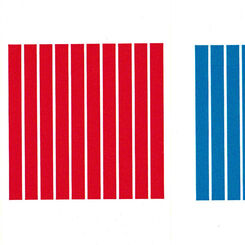
Marcello Morandini
Modern designs by Italian artist Marcello Morandini using the simplest of forms and colours.

Spanish-suited deck by J.Y. Humphreys
A rare Spanish-suited deck published by J.Y. Humphreys, Philadelphia, c.1816.

Storia del Fascismo
Published by Il Meneghello, this pack provides a visual history of Fascism in Italy between 1919 and...

75: Early American cards
An overview of some of the early cards made in the United States.
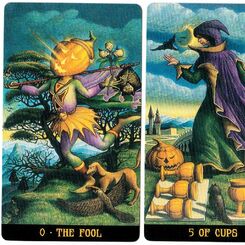
Jack-O’-Lantern Tarot
Giuliano Costa's Jack-O’-Lantern tarot blends Rider-Waite symbolism with the rich and atmospheric th...

Schwarze Katze (or Gioco del Gatto Nero)
Reproduction of a 40-card transformation pack with designs by “WS”, adapted for the game of Black Ca...

Hot-Air Balloons & Co.
Hot-air balloons and airships from the early days to 1988, with designs by S. Baraldi and F. Tacconi...

Carte da Gioco Mongolfiere
Various hot-air balloons on a pack from a small Florentine publisher.

Mercante in Fiera di Jacovitti
Traditional Italian card game with comic designs by Benito Jacovitti.
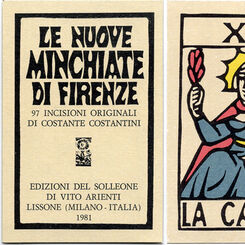
Le Nuove Minchiate di Firenze
Costante Costantini's second Minchiate deck, “Le Nuove Minchiate di Firenze”, was published by Solle...

Bolognese pattern
Standard Bolognese pattern pack by Murari of Bari.
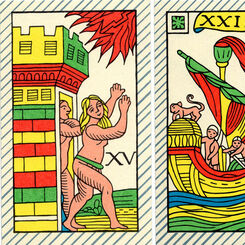
Minchiate Fiorentine
Minchiate Fiorentine created by Costante Costantini, published by Edizioni del Solleone.
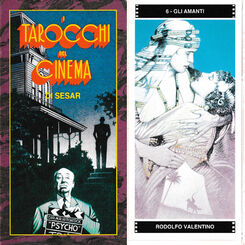
I Tarocchi del Cinema (di Sesar)
A set of Tarot trumps on the subject of the cinema, with designs by Sergio Sarri.
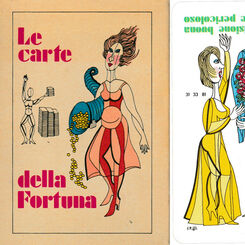
Le carte della Fortuna
Modern Italian fortune-telling pack from 1975, with designs by Sergio Ruffolo.

Art Nouveau Oracle
A Lenormand-type fortune-telling pack in the Art Nouveau style.
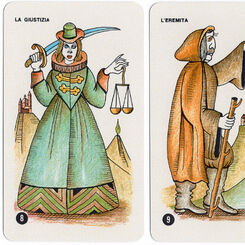
Tarocco Indovino
Sergio Ruffolo’s “Tarocco Indovino” is an expanded version of his “Lo Zodiaco” cartomancy deck.

Il Mercante in Fiera del Solleone
Traditional Italian card game with bold designs by Costante Costantini.

Venus et Cupidon
“Venus et Cupidon” from Costante Costantini in his distinctive woodcut style.
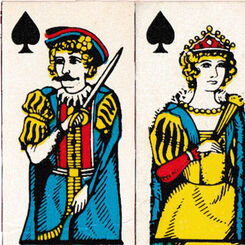
Italia playing cards
Small, narrow cards designed by Osvaldo Menegazzi, bearing a strong resemblance to a Swedish pattern...

Napoleone playing cards
Long, narrow cards designed by Osvaldo Menegazzi, featuring Napoleon, Josephine and various soldiers...

Consorzio Vino Chianti Classico
Promotional pack for Chianti Classico wine, with designs by Costante Costantini.

Burgdorf Abschreckhärtetechnik
Promotional pack for a German steel hardening business, with designs by Costante Costantini.
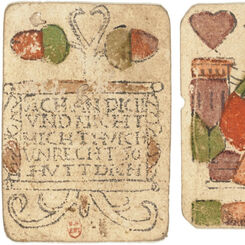
Early German playing cards
Some early examples of popular German playing cards from the XV and XVI centuries.
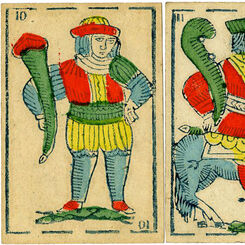
P. Buscaglia: Spanish-suited cards
Spanish-suited cards published by P. Buscaglia, Mele & Genova.

Carte Bolognesi
New designs reinforcing Bologna’s reputation as the gastronomic capital of Italy.


